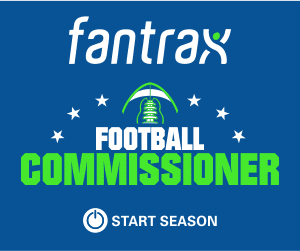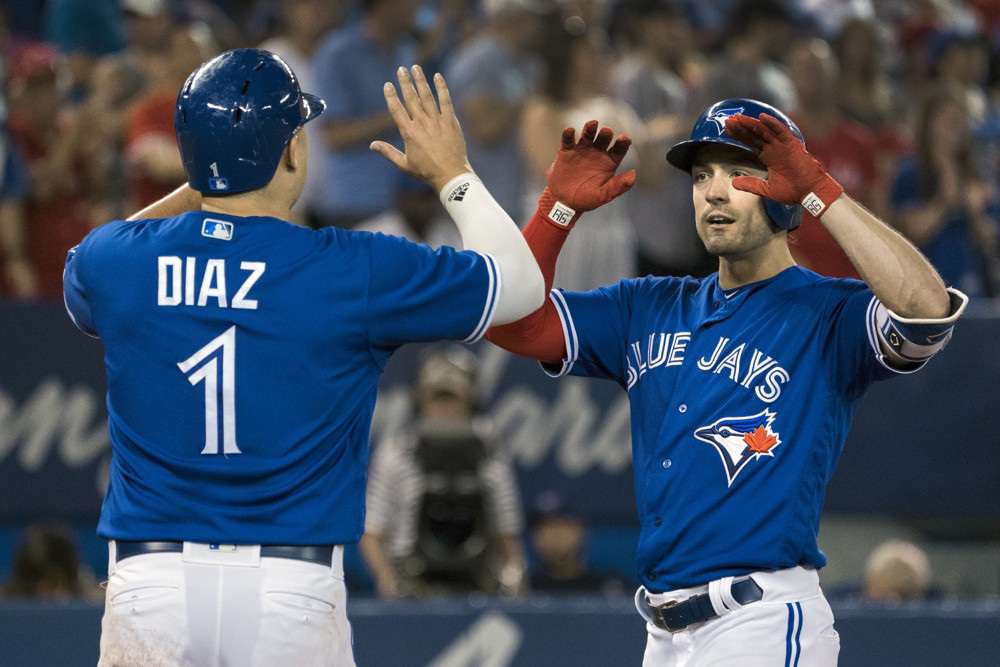In recent columns, I have offered short lists of players who can provide a boost in batting average and RBIs down the stretch. Still, there’s nothing like some good old-fashioned power hitters to give your team a lift. Home run hitters, in particular, can have a multiplier effect on your offensive categories, since homers (aside from the inside-the-park variety) aren’t subjected to the vagaries of BABIP, and they also add to your run and RBI totals. Yet finding home run help on waivers is not as easy as one might think in our current power-friendly environment.
 If you play in a deeper league — say a mixed league with at least 15 teams — there are few waiver wire options for enhancing your team’s chances of moving up in the home run category. However, in even a slightly shallower league, three hitters stand out as potential waiver options and home run help. All three are Blue Jays, and as such, they are helped out by a home park (Rogers Centre) that is amenable to home run hitting, as well as by a schedule that takes them to Yankee Stadium and Oriole Park at Camden Yards for a combined 12 games over the final seven weeks.
If you play in a deeper league — say a mixed league with at least 15 teams — there are few waiver wire options for enhancing your team’s chances of moving up in the home run category. However, in even a slightly shallower league, three hitters stand out as potential waiver options and home run help. All three are Blue Jays, and as such, they are helped out by a home park (Rogers Centre) that is amenable to home run hitting, as well as by a schedule that takes them to Yankee Stadium and Oriole Park at Camden Yards for a combined 12 games over the final seven weeks.
The appeal of this trio of sluggers goes far beyond favorable power-hitting venues. Here’s what makes each of these hitters a worthy target to add for the home stretch, whether by way of a waiver claim or a trade.
Home Run Help for the Stretch Run
Randal Grichuk, OF, 54 percent owned in Fantrax leagues
Throughout his four years with the Cardinals, Grichuk built a reputation as a streaky hitter, alternating periods of robust power production with lengthy cold snaps. His first season with the Blue Jays could be viewed similarly. Just over three weeks into the season, Grichuk was batting .088, then lost playing time, and on the last weekend of April, sustained a sprained knee that landed him on the DL. Since his return on June 1, Grichuk is batting .265 with 14 home runs, 38 runs and 36 RBIs. The home run and run production pace are enviable, and the batting average is 20 points above his career mark.
In some ways, this version of Grichuk is the old Grichuk. With a 40.9 percent ground ball rate since the beginning of June, he continues to favor launching the ball in the air, and his generous 52.6 percent pull rate during this particular hot streak is largely in line with his typical rates around 50 percent.

While his heavy pull tendencies (as displayed in the spray chart from FanGraphs just above) will act as a damper on his batting average, a lower strikeout rate could counteract them. If Grichuk can maintain something close to his 21.8 percent strikeout rate from June forward, he shouldn’t be a drag on batting average. Better yet, the more frequent contact could give him more opportunities to drive balls out of the yard and give you that home run help you’re seeking.
Kendrys Morales, 1B, 45 percent owned in Fantrax leagues
All season long, Morales’ numbers haven’t quite added up. Among hitters with at least 150 batted balls, Morales ranks in the top 15 percent in average exit velocity on flyballs and line drives and in the top 10 percent in barrels per plate appearance. With a 20.8 percent strikeout rate, he is not getting robbed of home run-hitting opportunities due to poor contact skills. Yet Morales rolled into Monday’s series opener with the Royals with 13 home runs in 351 plate appearances and a very ordinary .172 Iso.
It’s hardly surprising, then, that of all hitters with at least 300 plate appearances, no one has a larger positive discrepancy between their xSLG and their actual SLG. Morales .414 SLG falls 103 points shorts of his xSLG, but to get a sense of how much better he could be, take a look at how he compares with a hitter with a similar profile.
[table “221” not found /]Carlos Correa’s 31.1 percent hard contact rate is exactly 11 percentage points lower than Morales’, and his strikeout rate is nearly four points higher, but otherwise, they have been comparable hitters this season. Correa’s .464 SLG is 50 points higher than Morales’, and he has a 32-point advantage in ISO. If Morales can maintain his current batted ball profile, he should hit for more power than Correa has up to this point (and hit for a higher batting average, too).
Aledmys Diaz, 3B/SS, 42 percent owned in Fantrax leagues
The Cardinals traded Diaz to the Blue Jays just a month-and-a-half before they dealt Grichuk north of the border, but that’s not where the similarities end. Diaz has strong pull tendencies and has had to overcome a slow start to the 2018 season as well as a stint on the disabled list back in May. It took Diaz longer to find his groove once he returned from his sprained ankle, but since July 1, he is batting .296 with eight home runs in 102 plate appearances. His 52.2 percent pull rate during this period is clearly reflected in his .250 BABIP, but he has still managed to flirt with a .300 batting average over this span because he has struck out only seven times (for a 6.9 percent strikeout rate).
Diaz does not have the same raw power that Grichuk has, but that’s setting the bar high, as his teammate ranks 14th in average exit velocity on flyballs and line drives at 97.0 mph. Still, Diaz’s average of 93.1 mph puts him in the upper half of the rankings, and his lack of strikeouts gives him more opportunities to launch homers. As the table below shows, Diaz profiles similarly to Didi Gregorius, yet while his Yankee counterpart is universally owned in Fantrax leagues, he is still on waivers in a majority of leagues.
[table “222” not found /]Statistical credits: FanGraphs, Baseball Savant, xStats.org. All 2018 stats are for games played through Sunday, August 12.
 Keep up with all the latest Fantasy Baseball happenings with Van Lee, Jeff Zimmerman and Rob Silver on the Launch Angle Podcast.
Keep up with all the latest Fantasy Baseball happenings with Van Lee, Jeff Zimmerman and Rob Silver on the Launch Angle Podcast.

